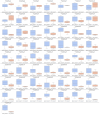Altered Expression of Neuroplasticity-Related Genes in Alcohol Addiction and Treatment
- PMID: 39518903
- PMCID: PMC11546795
- DOI: 10.3390/ijms252111349
Altered Expression of Neuroplasticity-Related Genes in Alcohol Addiction and Treatment
Abstract
Alcohol use disorder's complexity arises from genetic and environmental factors, with alcohol metabolism genes and neurotransmitter pathways being critical. This study aims to analyze synaptic plasticity gene expression changes in individuals with AUD in order to study their contribution to AUD development and to identify potential biomarkers of treatment response. RNA was extracted from whole peripheral blood (20 patients, 10 healthy controls), before and after treatment (Qiagen AllPrep RNA/DNA Mini Kit), and the gene expression of 84 genes related to neuroplasticity was studied using the RT2 Profiler for Human Synaptic Plasticity RT-PCR Array (PAHS-126ZA, Qiagen), comparing AUD patients to control and responders to non-responders. The potential prognostic/predictive biomarkers were searched using machine learning models. A total of 35 dysregulated genes were found in AUD patients. EPHB2, EGR, and AKT1 were increased, while TIMP1, NCAM1, and GRM2 were decreased. Responders showed distinct gene expression profiles at baseline. After treatment, the expression of 57 genes was normalized, while NCAM1, GRM2, and BDNF showed the most significant recovery. EGR4, INHBA, and NCAM1 emerged as potential biomarkers to predict treatment success. These results indicate that gene profiles in peripheral blood can serve as prognostic markers for the prognosis and treatment of AUD, although further validation is required.
Keywords: alcohol use disorder (AUD); biomarker; gene expression; neuroplasticity; synaptic plasticity.
Conflict of interest statement
The authors declare no conflicts of interest.
Figures






References
-
- World Health Organization (WHO) Alcohol Consumption Greece. ALCOHOL CONSUMPTION: LEVELS AND PATTERNS. 2016. [(accessed on 10 September 2024)]. Available online: https://cdn.who.int/media/docs/default-source/country-profiles/substance....
-
- Tsoumakas K., Tanaka M., Petsios K., Fildisis G., Gkoutzivelakis A., Pavlopoulou I. Alcohol Drinking Habits and Negative Experiences among Adolescents in Greece. Open J. Pediatr. 2014;04:222–230. doi: 10.4236/ojped.2014.43029. - DOI
MeSH terms
Substances
LinkOut - more resources
Full Text Sources
Medical
Research Materials
Miscellaneous

